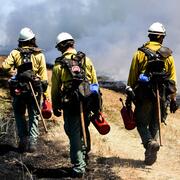Wildland Fire Research
The USGS Wildland Fire Science Program produces information to identify the causes of wildfires, understand the impacts and benefits of both wildfires and prescribed fires, and help prevent and manage larger, catastrophic events. Our fire scientists provide tools that are used by stakeholders to make decisions before, during, and after wildfires in ecosystems across the U.S.













